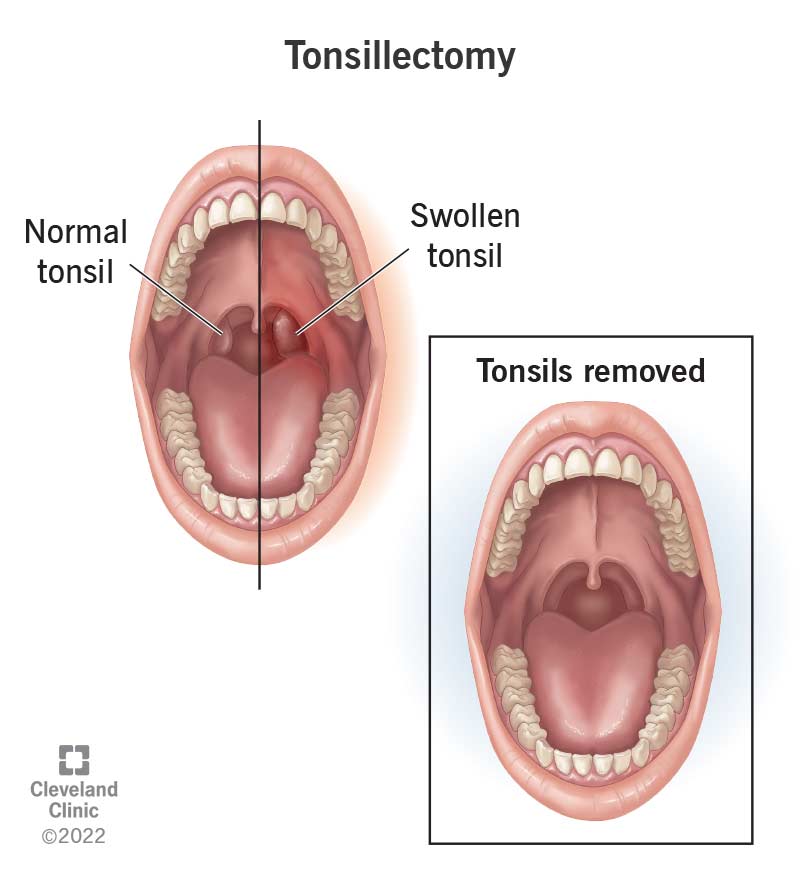Tonsillectomy is the surgical removal of your tonsils. It’s done to treat sleep-related breathing issues or frequent infections. While surgeons perform tonsillectomies less often than they used to, the procedure is still common today. Tonsillectomy recovery takes up to two weeks.

Tonsillectomy (pronounced “tahn-suh-LEK-tuh-me”) refers to the surgical removal of your tonsils. Your tonsils are round, fleshy masses in the back of your throat. Unless you’ve had them removed, you have two — one on each side.
Most of the time, surgeons remove all portions of your tonsils during this procedure. But some people might only need a partial tonsillectomy.
Healthcare providers recommend tonsillectomy for two main reasons:
While most tonsillectomies treat children, adults can also benefit from the procedure.
Tonsillectomies aren’t as common today as they were a few decades ago. Still, surgeons currently perform over 500,000 tonsillectomies every year in the U.S.
Cleveland Clinic is a non-profit academic medical center. Advertising on our site helps support our mission. We do not endorse non-Cleveland Clinic products or services. Policy
Before surgery, your healthcare provider will do a routine check to make sure you’re healthy enough for surgery. They may also request blood tests.
Your healthcare provider will give you a list of detailed preoperative instructions. You should follow these guidelines closely.
Your healthcare provider will give you general anesthesia to keep you asleep and comfortable during your procedure. Next, they’ll remove your tonsils. You won’t feel pain during this step. Surgeons use many methods to perform tonsillectomies, including:
In most cases, a tonsillectomy takes about 20 to 30 minutes to complete. It could take longer in some instances.
After your tonsillectomy, your medical team will transfer you to a recovery area. There, your provider will check your vital signs (blood pressure, heart rate and blood oxygen levels) and make sure there are no postoperative complications.
Tonsillectomy is usually an outpatient procedure. This means you can go home on the same day. Complications are rare, but if they arise, your provider might keep you in the hospital overnight to monitor your progress.
Having a tonsillectomy can offer many benefits, including:
While complications are rare, they can happen. Some possible risks include:
On average, most people reach full recovery in about two weeks. Overall recovery time depends on several factors, including the type of tonsillectomy you had, your body’s healing capacity and whether you experienced any complications.
While healing looks a little different for everyone, here’s a general timeline of what to expect during tonsillectomy recovery:
Drinking plenty of fluids is key to a successful tonsillectomy recovery. In addition, you’ll probably want to eat soft, cool foods for the first week. You can introduce solid foods once your comfort level allows, but you should avoid hard and spicy foods, as they can irritate the surgical area.
Food and drink recommendations during tonsillectomy recovery include:
It’s best to take at least 10 days off work or school following a tonsillectomy. Staying at home helps reduce your risk for colds or other postoperative infections.
After a tonsillectomy, you should call your healthcare provider if you develop:
You can expect to feel some discomfort following a tonsillectomy. In general, recovery is more difficult for adults than children. This is a normal side effect and should go away in a couple of weeks. Your healthcare provider will give you medications and post-operative instructions to help ease your discomfort.
Many people wonder if removing their tonsils will have a negative impact on their immune systems. Research shows that having a tonsillectomy doesn’t result in reduced immunity. In fact, some studies show that the opposite is true: Many people who have a tonsillectomy experience an improved immune response. Keep in mind, though — even if you have your tonsils removed, the tissues in your throat can still become infected and sore.
A note from Cleveland Clinic
Tonsillectomy is the surgical removal of your tonsils. Surgeons perform the procedure to treat breathing-related sleep disorders or chronic tonsillitis. Even though tonsillectomies are somewhat less common today, surgeons in the U.S. still perform over 500,000 procedures every year. If you have frequent tonsil infections or difficulty breathing during sleep, ask your healthcare provider if a tonsillectomy could help.
Last reviewed by a Cleveland Clinic medical professional on 10/17/2022.
Learn more about our editorial process.
Cleveland Clinic is a non-profit academic medical center. Advertising on our site helps support our mission. We do not endorse non-Cleveland Clinic products or services. Policy